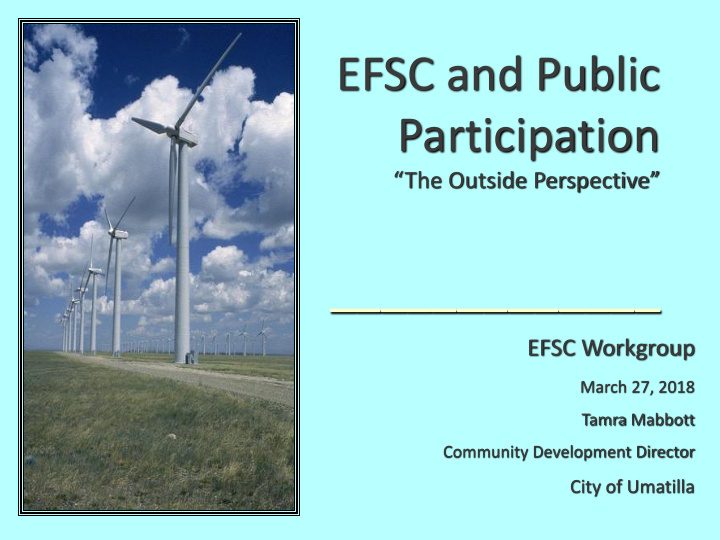



EFSC and Public Participation “The Outside Perspective” _____________ EFSC Workgroup March 27, 2018 Tamra Mabbott Community Development Director City of Umatilla
Energy Facility Siting in Oregon 1.Oregon’s Statewide Planning Program 2. Issues in Columbia Basin 3. Recommendations
Pop QUIZ What do Prisons and Energy Facilities Have in Common?
Public interest in wireless technology and data storage? Public interest in transportation? Yes, but neither are subject to super siting.
Transportation and Energy Energy Transportation A. Oregon Highway A. Biennial Energy Report Plan B. No local Plans B. Local TSP’s C. Local permitting C. Local Permitting for small projects. D. Public Investment D. Private E. Public Need Investment E. Public Need
Statewide Planning Goals Goal 1 Citizen Involvement Goal 2 Land Use Planning Goal 5 Energy is deemed a significant resource if “an application has been submitted to EFSC.” Goal 12 Transportation Goal 13 Energy Conservation
Comparison of Standards: State Vs County Wind Energy Facilities Siting (page 1 of 2)
Comparison of Standards: State Vs County Wind Energy Facilities Siting (page 2 of 2)
Issues in the Columbia Basin Energy Generation Area (EGA) Solar Siting and AVA designation Transmission Line Siting (farm land protection and high value soil versus locational dependency)
Recommendations State Agency Coordination – Update DOE State Agency Coordination Program. ORS 197.180 and OAR 660 - 030 Reconcile definition of “energy facility” and “utility facility necessary for.” Condemnation not intended for private development. Increase regulatory threshold – Buy local! PUC – Continue oversight of Public Utilities – –
Recommendations continued Adopt a Statewide Energy Plan, similar to Oregon Highway Plan. Streamline process for projects on the State Plan. Adopt local energy plans and update Goal 13 at local level. Evaluate cumulative impacts of transmission lines.
Discussion
What is the State Agency Coordination Program? Oregon Revised Statue Chapter 197.180 State agency planning responsibilities; certain information to be submitted to department; determination of compliance with goals and plans; rules; exceptions; Oregon Administrative Rules Chapter 660 OAR 660 Division 30 The purpose of this division is to respond to the legislative findings and policy….implements provisions in SWPG 2 …and explains the relationship between OAR chapter 660 divisions 30 and 31. The purpose of Commission certification of agency coordination programs is to assure that state agency rules and programs which affect land use comply with the statewide goals and are compatible with acknowledged city and county comprehensive plans. 16
Save additional slides for use during discussion.
Permitting Agencies State Jurisdiction Oregon Public Utility Commission (OPUC) Energy Facility Siting Council (EFSC) Local Jurisdiction – Cities and Counties Conditional Use Application Review and Approval for Generation Facilities Land Use Decision for Transmission Lines Follow State Agency Coordination requirements
Jurisdictional Threshold Large(r) Projects Energy Facility Siting Council (EFSC) jurisdiction “top down” approach. 25 MW (105 MW wind) Small Projects – County or City “ subjurisdictional ” less than 25 MW
Transmission Line Regulatory Oversight Federal Jurisdiction Federal Energy Regulatory Commission (FERC) National Transmission Technical Coordination State Jurisdiction Energy Facility Siting Council (EFSC) Oregon Public Utility Commission (PUC) Land Conservation & Development Commission (LCDC) – OAR Standards Local Jurisdiction Local process with LUD Standards Health and Safety Concerns Visual Impacts Limited Opportunity for Master Planning
Resources: 1. “The Slow Evolution of Energy Planning – One State’s Experience,” August 2017, Ed Sullivan. 2. “Transmission Siting in the Western United States: Overviews and Recommendations Prepared as Information to the Western Interstate Energy Board, August 2009,” Holland & Hart 3. Oregon Department of Energy Biennial Energy Report http://www.oregon.gov/energy/Data-and-Reports/Pages/Biennial- Energy-Report.aspx 4. Statewide Planning Goal 13: Energy Conservation
Siting Transmission Lines Checklist (page 1 of 2)
Siting Transmission Lines Checklist (page 1 of 2)
OAPA Legislative Policy Update Goal 13: Energy. OAPA recognizes the need to review and update Goal 13 Energy Conservation for the 21 st Century. OAPA supports a comprehensive energy goal that incorporates and balances other goals with the desire to conserve energy, balance impacts of energy development and encourage development of a sustainable energy supply for Oregon. We support renewable and sustainable energy development, policies, and the regulations that balance impacts to resource lands and people. OAPA encourages changes to state law to shift the role of final permitting from state agency super siting to local governments.
Recommend
More recommend